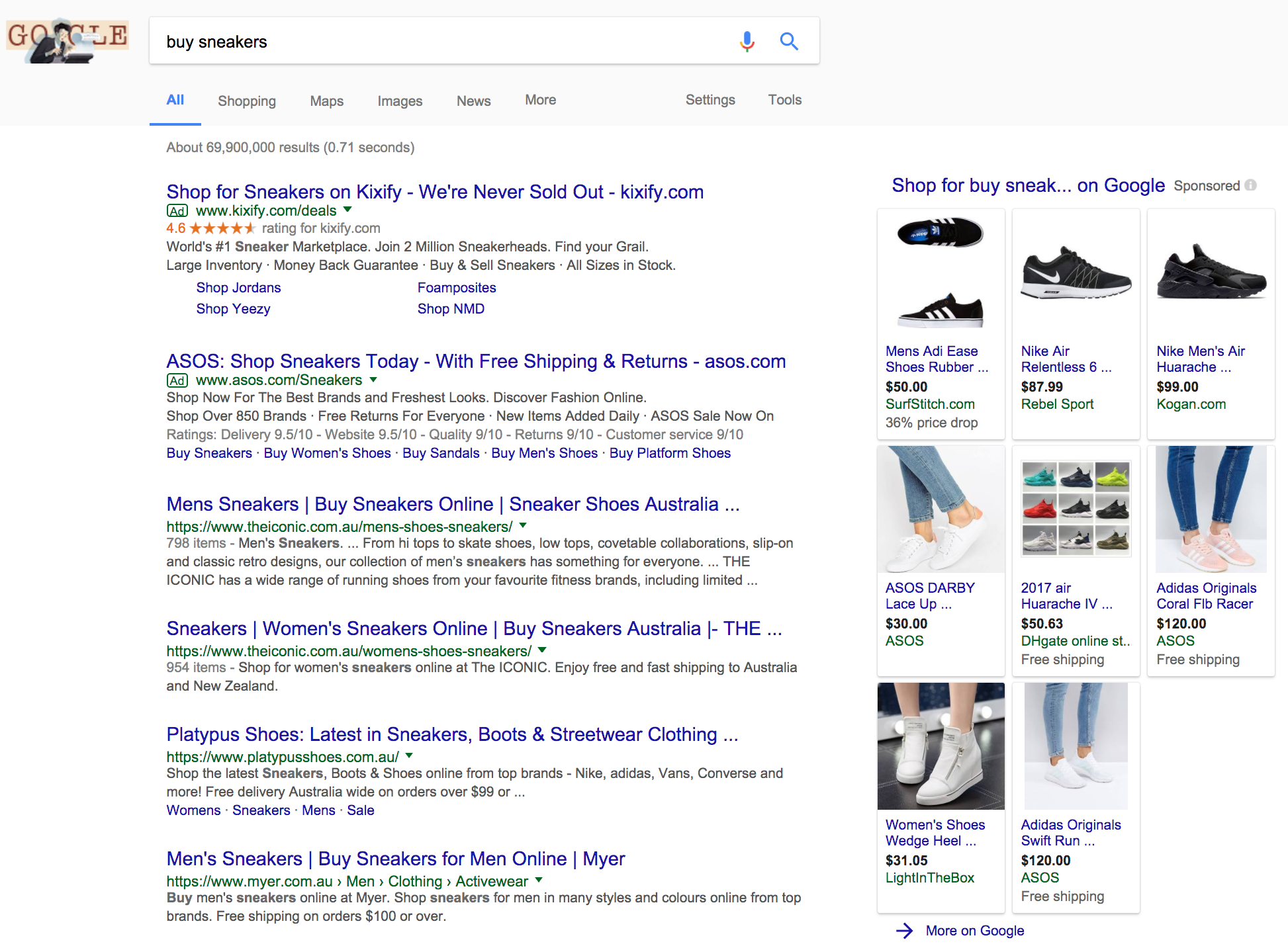
7 Home Truths You Need to Consider Before you Begin SEO Activity
Are you about to embark on a search engine optimisation (SEO) program? Have you launched a new website and learned that you need to do more than simply build it for “them to come”? Before you throw yourself headlong into meta titles and backlinks, here’s some important things to consider.
1. Keyword rankings are a stupid metric
There I said it.
Consider this?
Do you rank number 1 on Google? Great!
- For what keyword?
- In what location?
- On what device?
- Was the user logged In?
- Had they visited your site before?
There are now so many variables that effect the specific rankings, for a specific search query, for an individual user that the very idea that you can measure “the” position of a keyword is absurd.
That said, keyword rankings are undoubtedly worth measuring.
It’s just I wouldn’t rely on them as your single source of truth when measuring the performance of your SEO activity.
Instead consider these alternative measures;
- Sales from organic search
- leads from organic search
- Sessions or site traffic from organic search
If these measures are improving, then your organic search activity is undoubtedly working.
If at the same time you are seeing positive signs that your keyword positions or rank are also improving (broadly speaking), then things are going well.
Finally if you are tracking keyword rankings (and you should be). Bear in mind the weaknesses that I have outlined and accommodate for these in your reporting, in a way that is meaningful for your business.
For example, a keyword tool like AWR Cloud allows you to set a location or device for your keyword rank tracking.
So if Melbourne is your key region, you can set your tracker’s location to Melbourne and get a better indication of your performance in that region.
Do your best leads come from Mobile devices? Then set your rank tracker to measure the performance on a mobile device.
Or if you are really keen, you could measure across a range of key regions and devices to get an even spread of your indicative performance across the regions and devices which are most critical to your business.
A quick scan of these reports will give you a much better indication of how your search engine optimisation activities are performing than an obsessive focus on keyword X.
2. Not all search results are created equal?
Have you ever heard the term SERP? SERP stands for search engine results page and if your about to embark on an SEO campaign, then you will see it used a lot.
The important thing to note here is that not all SERPS are the same. Have a look at the different search results pages below.
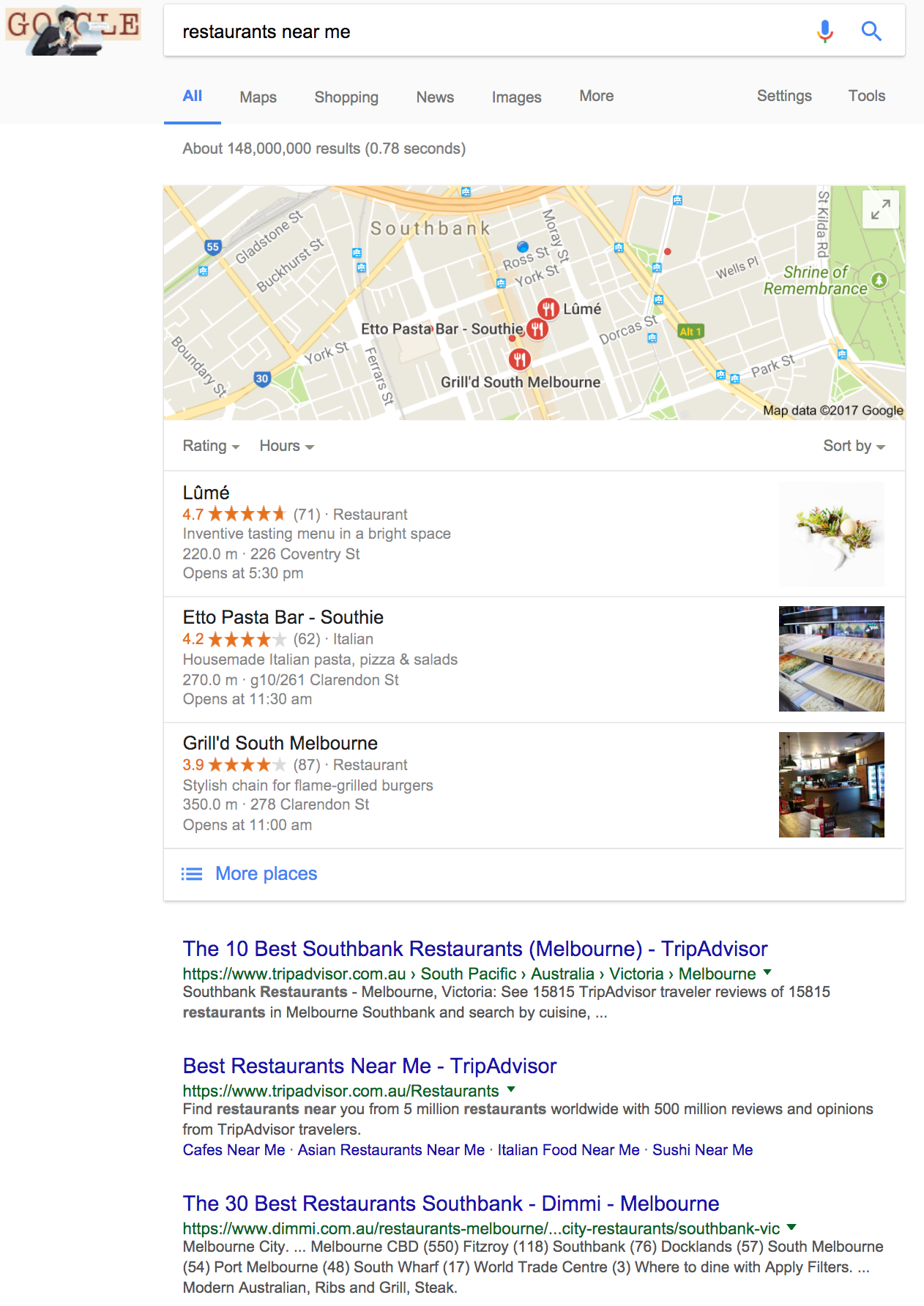
In the SERP example above, Google preferences local Google My Business listings and directory sites above individual restaurant websites.
In this SERP example Google preferences retailers and also allocates a large amount of real estate to Google Shopping ads.
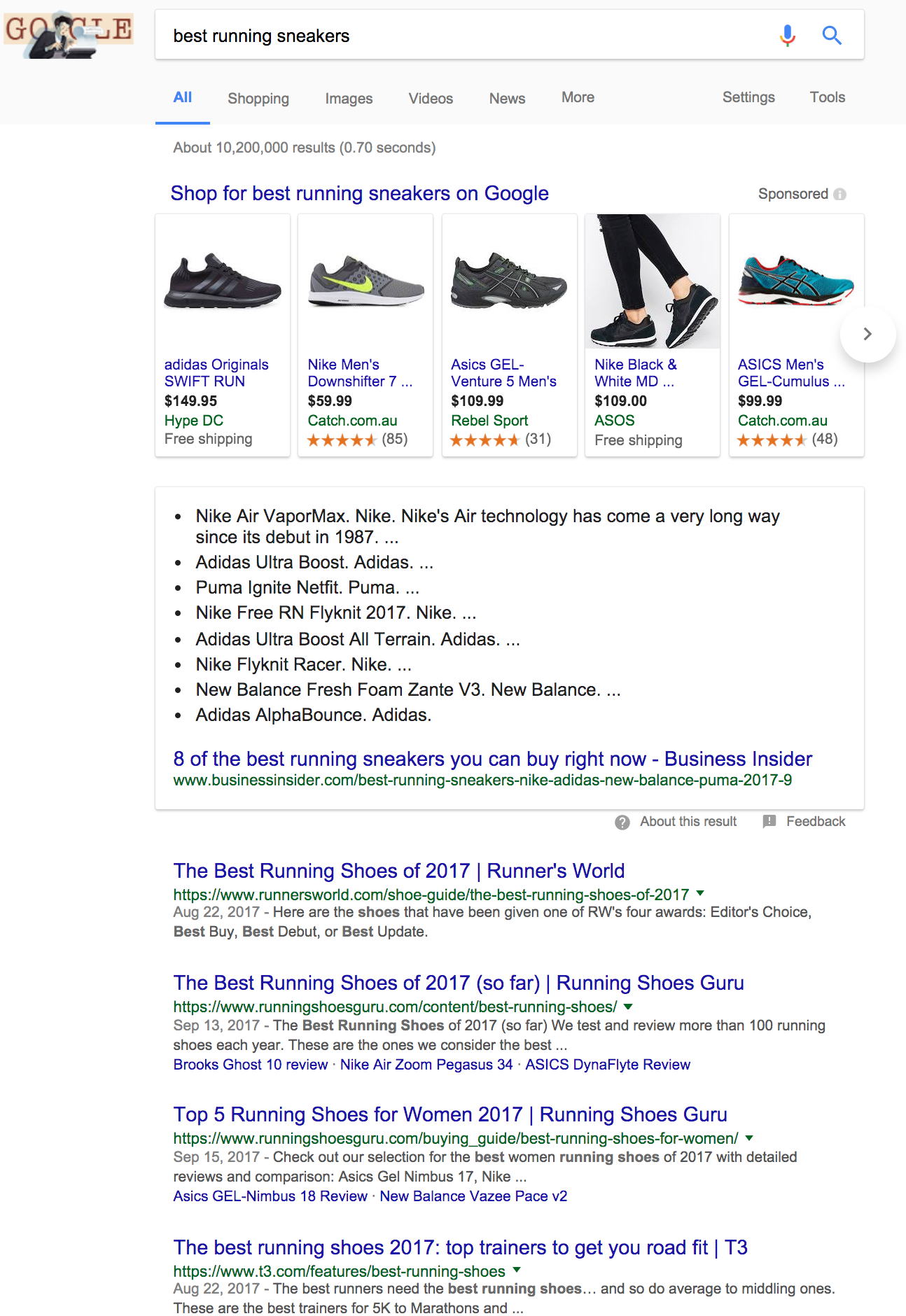
In this SERP example, Google still allocates a significant amount of space to Google Shopping ads, but now the organic listings include only review sites and Google have also included a featured snippet which pulls information directly from one of the sites within the top organic positions.
You can see from these examples just how different each search engine result page is on Google.
These are just a small sample of the many variations that Google could throw up.
Some perference local results others will highlight videos or images, some have shopping ads.
If you are a commercial business trying to sell products and 100% of a SERP contains reviews sites, it’s probably not realistic that you’re ever going to be able to get your website ranking in amongst all those reviews sites.
The Google Gods have spoken. That SERP will forever be for reviews sites.
Maybe getting listed on the top ranked reviews site or using paid search ads will be your best play.
3. There are no shortcuts for SEO. Repeat, none. Shortcuts no.
Back in the early days of SEO, there were many creative and interesting ways to game the system.
Today, most of the sites that benefited from those early hacks have either retired early or gone out of business.
There’s not a lot of middle ground sadly.
So if you are considering any of the following, stop. Trickery won’t work, they are a waste of time and money and are more likely to get your site penalised than shooting up the Google rankings.
Don’t use these shonky techniques;
a) Paying for links. No, bad don’t do it. Google is not stupid. If you can find a website selling links, believe me, Google already know that they exist.
And on the very unlikely chance that they haven’t figured out where these links are being built, it won’t take them very long.
More importantly when they do discover these paid link farms, what do you think they are going to do with the sites that paid to have links added there?
“Oh you shouldn’t have done that, but you seem like a nice respectable business, here take the #1 position for your most competitive keyword.” Not likely.
It’s just not worth the risk.
b) Hiding Text Really? Why are you even considering this?
Google’s algorithm understands code, if you really think that it can’t tell that your body text is the same colour as your background or that your text is aligned 1000 pixels to the left of your page, then you are kidding yourself.
It’s not happening. In most situations you need a certain amount of textual content on a page to rank for a particular keyword.
If you don’t want your site visitors to see the text on the page, you have to ask yourself some hard questions about your motivation for putting it there in the first place.
And if you just found yourself thinking “what if we just put in an expandable div block?” or “What if I just used a colour very close to our background, but not identical” then you’re missing the point.
Generally I see these ideas crop up when you want to rank for a generic term that differs from an internal marketing term that you use for a product or service.
Or perhaps you have trademarked a term that you want to “own”
There’s often very good reasons for these tactics, but from an SEO perspective there are also often very good reasons to challenge these decisions.
If you want to rank for the word “sneakers” but your internal marketing term is “Cushioned foot vessel”, maybe you should just call them sneakers.
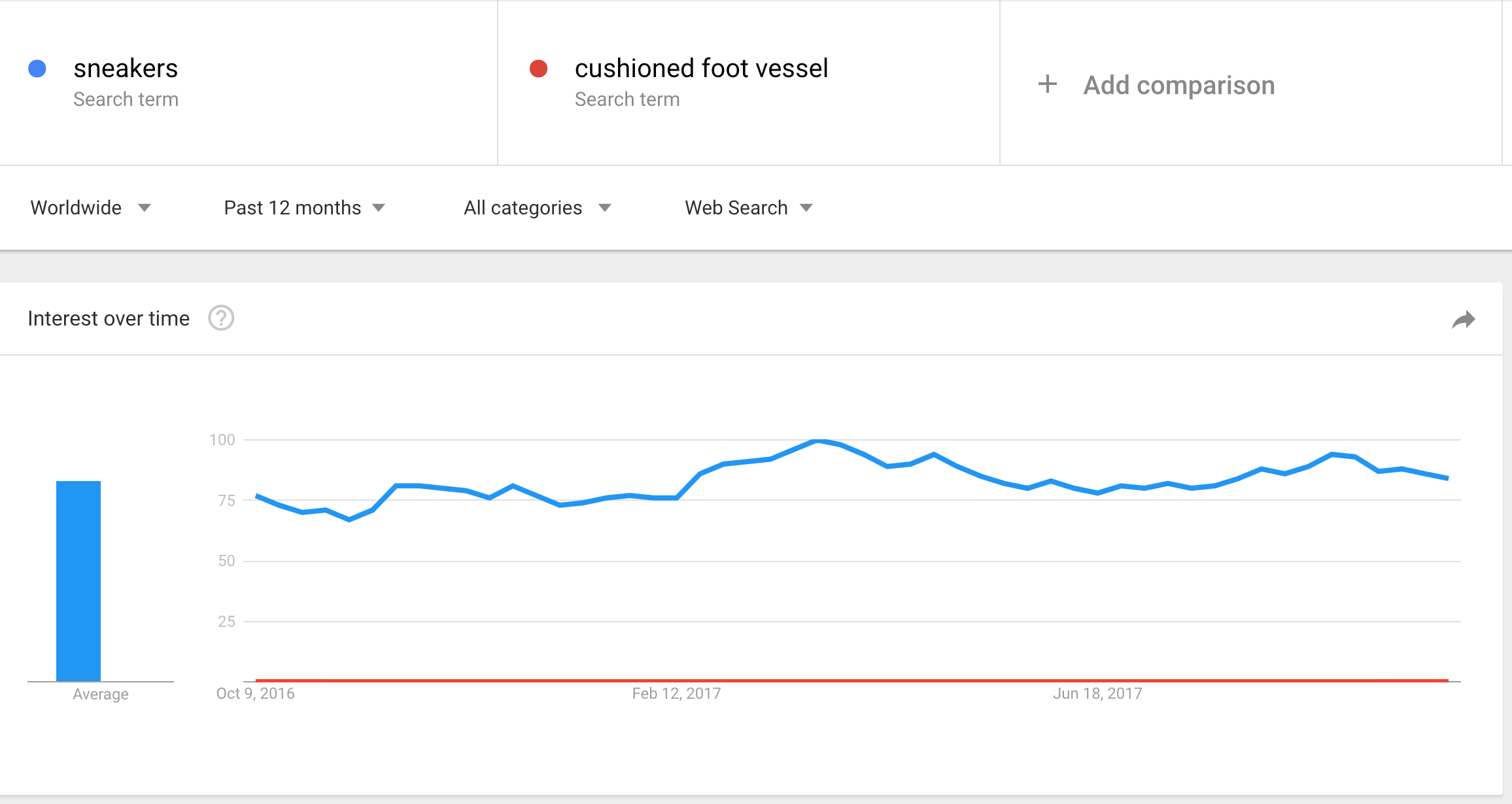
According to Google trends, there was a lot of search for “sneakers” over the past 12 months. Not much (or any) for “cushioned foot vessel” unfortunately.
The other major concern I sometimes encounter is that of visual aesthetic.
“We’ve created a stunning visual website and adding any text on the page will spoil our user experience.” Really?
I haven’t seen too many examples where adding contextually relevant textual content to the page can’t improve the user experience?
And if the creative geniuses who were somehow able to convey everything about your amazing product or service without so much as a single line of text, can’t introduce a few lines of copy to the page without spoiling the masterpiece. Then perhaps they are not the creative geniuses that we thought them to be.
c) Reciprocal Linking What is this 1998?
1998 was a great year and right now is an excellent time to open a bottle of 1998 Grange Hermitage, if you’re lucky enough to have one. As for 1998 link building techniques. hmmm. not so much.
If you’re not familiar with reciprical link building, it’s basically this. Contact 1000 websites and tell them that you will link to their site if they link to yours.
Again, this worked once upon a time, but if you’re reading this article, then you missed the boat on this one. Sorry about that. Google’s onto it, just don’t consider it. move on.
Link building today is about creating content which adds value.
Add enough value and people will share your content.
Better yet, say something unique and people will reference your content.
How have I gone so far? Is this article share worthy?

If you find yourself thinking “well that’s all well and good for other, more exciting businesses, but who would ever share content for my little widget company?” Well think again.
If you make widgets and your competitors make widgets, then you only need to be the most interesting widget company to make memorable, link worthy content.
Think of Blendtec. They make blenders. Not exactly the most “wow” product in the market.
But their “Will it Blend?” video content is one of the best examples of link worthy content marketing on the net. (Case in point, I just linked to it again. twice. It still works)

d) Buying Followers or Shares. ARE YOU KIDDING ME?
Google take into account the number of followers and shares in their ranking algorithm, so boosting these figures will give you an advantage, right?
Firstly Google don’t care how many followers you have and while Google may pay particular attention to social media when assessing trending topics and content that is “blowing up online”. If you think that paying $60 to a company in Bangladesh for 1000 social shares is going to “trick Google” into thinking your latest blog post has gone viral, then your kidding yourself.
4. Focus on Intent and keyword segments, not individual keywords.
If you’ve made it this far, then you probably understand what a keyword is. And yes you need them.
But if I can take this thinking a step further, the concept of keyword segments is an important one to get your head around.
If you think of all the keywords that could be relevant to your business, you can probably group them into segments based on intent.
By intent I mean if someone searching for “Furniture Removals Melbourne” they likely have the same intent as someone searching for “Melbourne Furniture Removal companies”. Right?
Group your keywords into segments based on intent and then ask yourself. Which page on my website would best address the intent behind this search.
Presto! You have found your target page. (Another important SEO concept to learn. You’re doing great!)
Every keyword segment should have a target page and that target page should be optimised ..wait for it. to provide the most relevant response to the searcher’s intent.
Not as you might have thought to include every keyword from the keyword segment at least 3 times.
Forget these outdated rules for optimal “keyword density”. These are a myth. I have seen examples of pages with no more than a single keyword located in the footer of the page outperforming pages with supposedly superior “keyword density”.
It’s all about meeting intent with the most valuable response.
5. Content is Crucial
Once you have addressed any technical issues, investing in quality content is one of the most important things that you can do to increase your organic search performance. If you’re about to embark on an SEO program, be prepared that content will play a big role.
According to HubSpot, organisations who “prioritise blogging are 13x more likely to see a positive ROI” than those who do not.
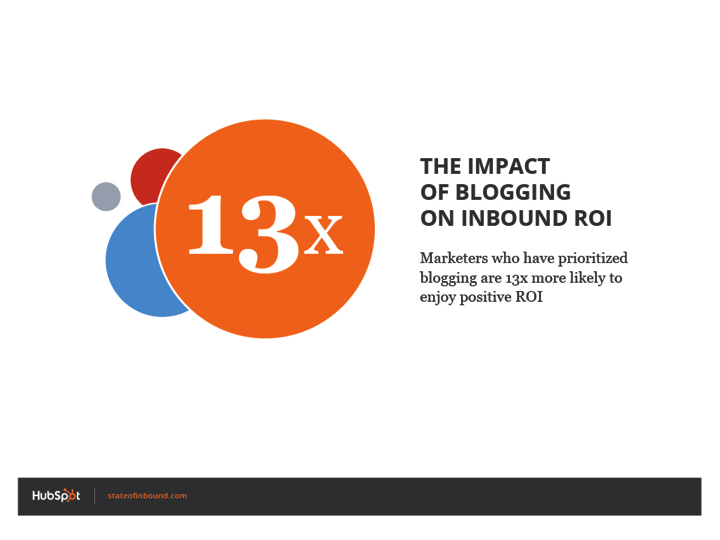
I’m not exactly sure how you go about proving a statistic like that, but one thing I will say is that of our clients, those that invest in content marketing and SEO together, get better results than those who invest in SEO alone.
6. Your customers are people not robots
Yes Google uses bots to crawl and index the web, but your users are people not robots.
Treat them accordingly.
As you embark on your SEO journey it will be tempting to start thinking about every website change through the lens of “what will the SEO impact be”
I’ll be the first person to advise that every marketer should have at least a basic understanding of core SEO principles. However…
Your focus should be on providing great value to your audience.
If you do this first and then apply solid SEO principles second, then you will achieve great success.
Certainly checking in with your SEO advisor – in what ever form they may take – is always a good idea before undertaking any major change to your site.
But making your SEO advisor the main decision maker for all web related activity, might not always produce the best results.
Balance good SEO fundamentals, with great user experience design.
7. Take a long term view
Finally. If you about to embark on SEO for the first time, then be prepared to commit to the long term.
If your goals are short term, then there are many marketing tactics that can achieve great results today.
SEO requires a little more patience.
The pay off is well worth it and in the long term there are not too many marketing activities that come close to delivering the sort of ROI that SEO promises.
But make sure that you have the buy in from your executive team, owner or whoever the powers that be, might be.
Invest quality time and appropriate resources into your SEO activity and commit to it as a major ongoing component of your overall marketing program and you will achieve great success.
